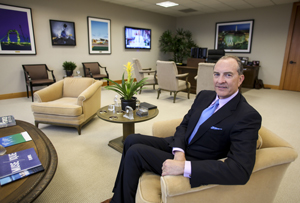Not many 72-year-olds can switch direction with agility, efficiency and speed, but that’s what Pasadena’s veteran Parsons Corp. is trying to do to stay ahead.
A reorganization initiative for this year is underway at the firm, which formed in 1944 as a construction and engineering business and then expanded over the decades into many diversified markets.
The plan, branded Forward, will restructure Parsons’ business segments into mostly independent standalone units with thinner management, greater financial responsibility and more accountability – think of it as a corporate version of parents pushing the kids out of the house to make their own way in the world.
Enabling organic growth from within like this is a switch from its historical strategy of growing by acquisition. During most years, the company has bought anywhere from one to three companies.
“We’re delayering some of our organization to further empower our customercentric teams, business development and customer service,” said Chuck Harrington, the firm’s chairman and chief executive since 2008.
Companies reorganize or restructure usually because they are having issues, such as seeing opportunities to grow but not being able to take advantage of them, said management and organization expert Gary Reuben, a faculty adviser and lecturer at UCLA’s Anderson School of Business. Too many layers can create inefficiencies and hurt those opportunities, he added.
“Companies sometimes find they want something different but the current structure is keeping them back from accomplishing it,” Reuben said.
Time to change
Parsons has 15,000 employees engaged in projects in 29 countries involving construction, engineering, oil drilling, transportation, design, environmental, bridges, water infrastructure, pharmaceuticals and telecommunications.
After some reshuffling and culling of about 200 employees under Forward, those markets now operate as five standalone business units – infrastructure, federal, construction, industrial and Middle East – with new leaders at the helm of each.
The reorganization also created positions at the top of Parsons. Executive vice president of operations, Dean Harwood, will manage all companywide operations and support. Parsons’ first chief of staff, Virginia Grebbien, will oversee marketing, communications, government relations and strategic functions.
Parsons began discussing the need for reorganization in July, Harrington said. Changes started taking place last month and should be completed by late spring.
“We saw a global environment that’s probably going to be low growth, and obviously there are places in the macroeconomy which will have negative growth – energy and gas,” Harrington said. To grow, Parsons has to be more agile, effective and efficient, he added.
Kansas City, Mo., construction and engineering firm Burns & McDonnell is structured similarly to Parsons, with 10-plus business units in several of the same industries. To keep clients happy, the company has few layers between employees and upper management, said Renita Mollman, general manager of its Southern California offices.
“Client satisfaction is priority for us; that’s why our organization is relatively flat,” Mollman said.
Parsons’ Harrington said thinning out management layers is intended to give customers more attention and quicker responses to their questions and requests. Competitors will lose out, he hopes, when bidding against Parsons for contracts.
But the driving purpose behind the reorganization boils down to growing the company. Revenue has hovered between $2.7 billion and $3 billion since 2005, except for a pre-Great Recession peak in 2008 of $3.4 billion, which it has yet to reproduce.
“Parsons remains profitable, but we undertook Forward to better position ourselves to continue winning and executing work in a very competitive environment,” Harrington said.
New strategy
“If you’re really trying to change the hearts and minds, and other things, what you’re trying to change is culture,” he added. “Internally, we’re inciting a revolution and a flag we can march around.”
Forward was also designed to boost performance so Parsons can reinvest the money back into the business units and grow them over the long term.
“This is all about doing what we do and doing it even better – like a championship sports team,” Harrington said. “You’ve won, but how do you win more? The competition is learning from what you did. They will catch up and this is about moving ahead. Great organizations are not stagnant but constantly moving forward.”

